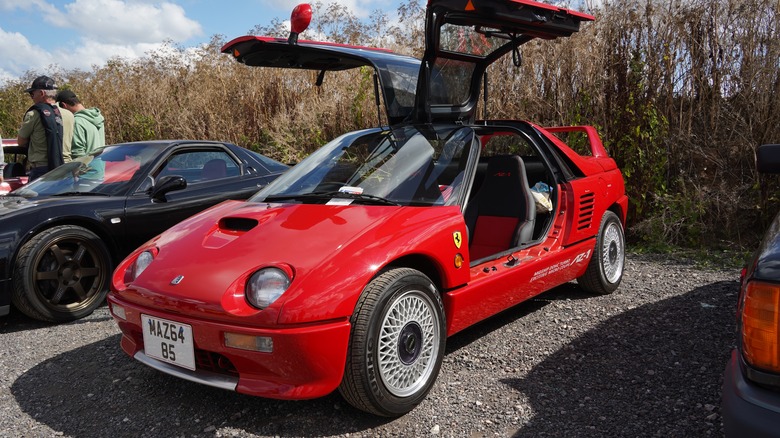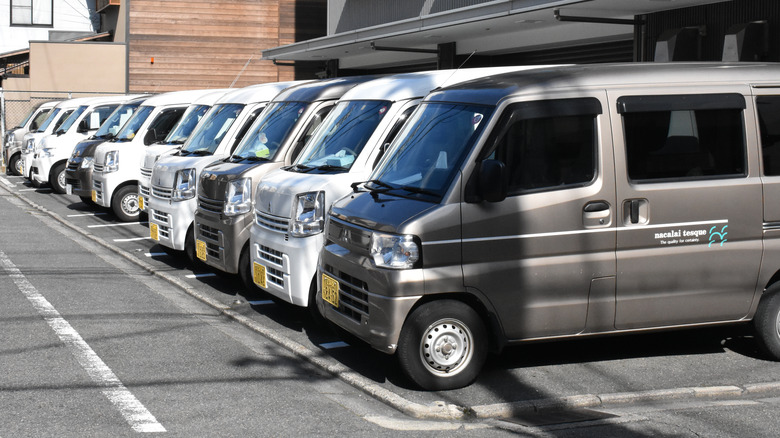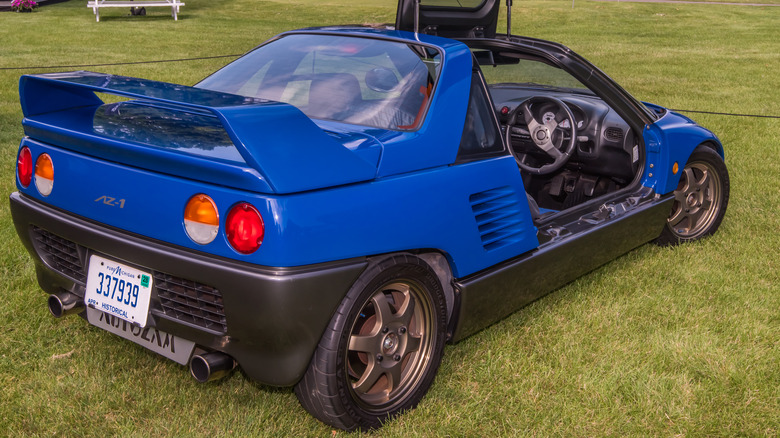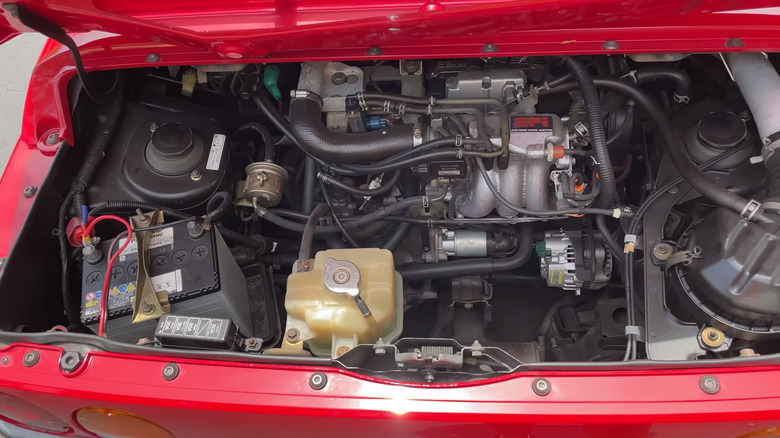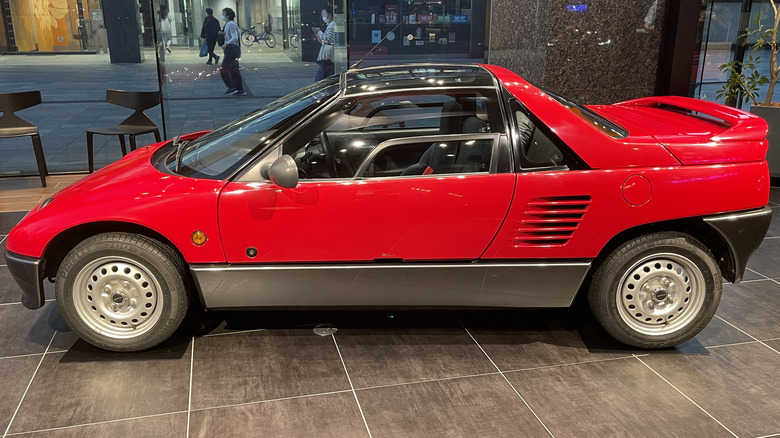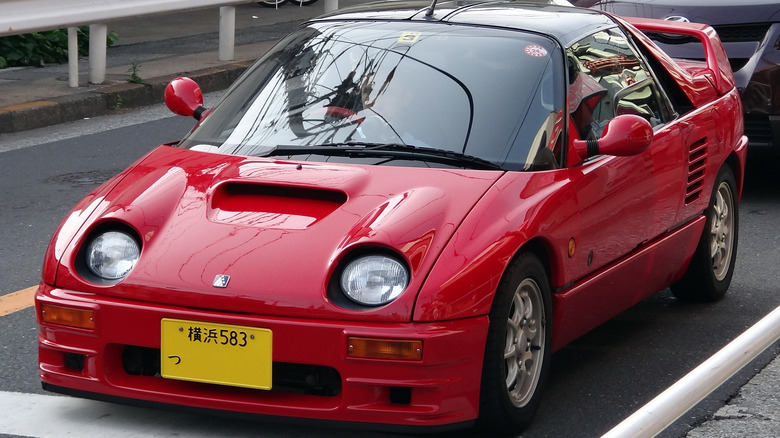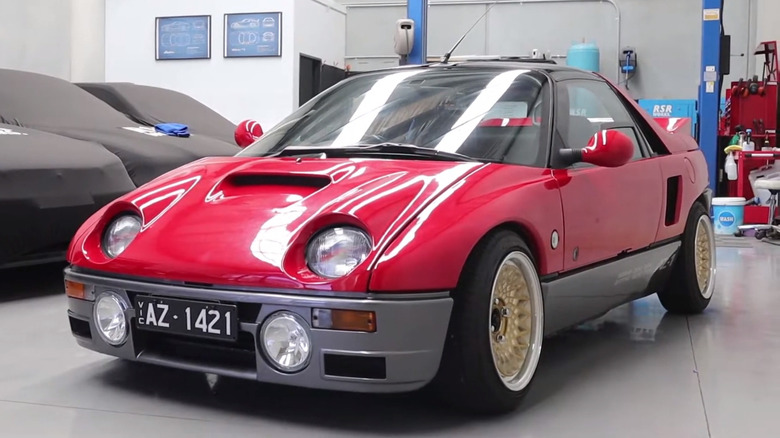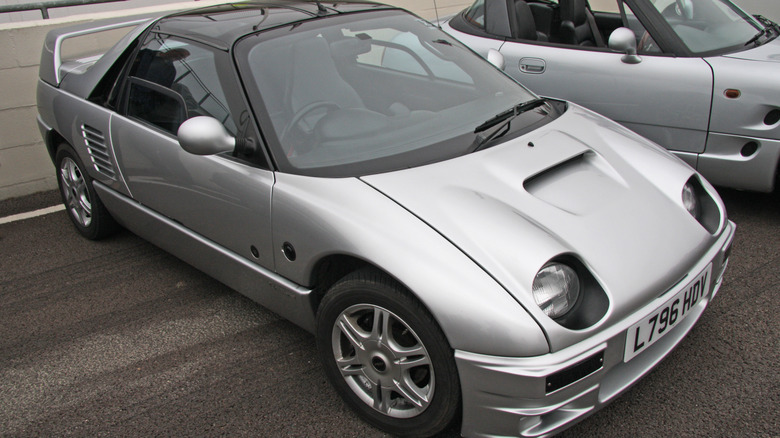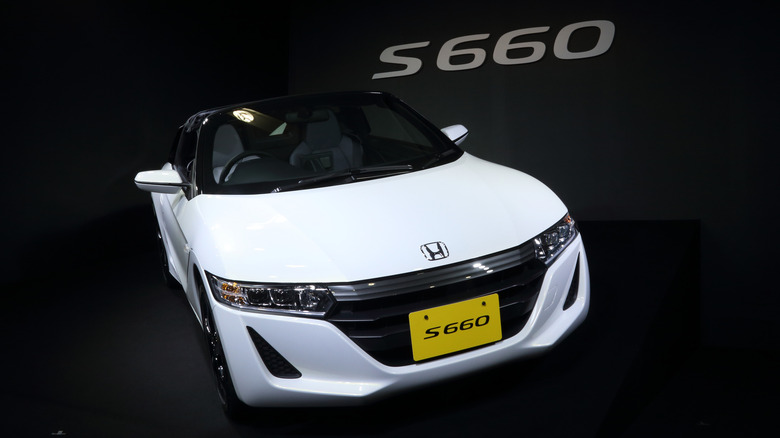8 Of The Coolest And Most Unique Features Of The Autozam AZ-1
Supercars are great, but they're inherently expensive, impractical, and inefficient. Kei cars are almost the polar opposite, being primarily designed as affordable, practical transport for the masses. Kei regulations in Japan guarantee much lower taxes on drivers than bigger-engined cars, making them cheaper to run, and their tiny size also makes them practical for tightly-packed city streets. Combining the two might seem like a crazy idea, but a group of Japanese engineers in the '80s went ahead and did it anyway.
The result was the Autozam AZ-1, one of the most unique kei cars ever built. It recently became legal to import to the U.S. under the 25 year rule, and has quickly gained a cult following. It's easy to see why — there simply isn't any other car quite like it. Ironically, that makes it stand out in a crowd even more than many of the supercars it originally took inspiration from.
Small size, big personality
In order to qualify for kei car status, a car must follow a strict set of rules that govern its size, engine displacement, and power output. The rules were last updated in 1990 to allow for engines up to 660cc in size, and they dictate that cars should be no larger than 11 feet in length, 4.9 feet in width, and 6.6 feet in height. They're also not allowed to exceed more than 63 horsepower — the power wars started by the Suzuki Alto Works being allegedly responsible for the last rule.
The Autozam AZ-1 had to meet that tough set of regulations, which makes its unique design all the more impressive. Cramming sports car-like proportions into such a small frame must have been no easy task, especially since most kei cars resort to boxy styling (pictured above) to maximize interior space. The exterior design takes inspiration from many of the greatest supercars of the era, taking cues from Italian exotics like the Ferrari F40 and Lamborghini Diablo. Inside, the car looks almost race-ready, with the bare minimum in amenities to save as much space and weight as possible.
The product of a defunct brand
The Autozam brand might not be familiar to enthusiasts without an encyclopedic knowledge of JDM cars, but it was actually a short-lived subsidiary of Mazda. The Autozam brand was formed at the height of the Japanese economic bubble to sell small, sporty cars, although its designs weren't always penned by Mazda. The AZ-1 was instead the product of Suzuki, which created the original RS/1 concept that debuted at the Tokyo Motor Show in 1985. Eventually, Suzuki decided to focus on a different sporty kei car design, releasing the Cappuccino, which would compete directly against the AZ-1.
The RS/1 design continued development under Mazda's leadership, with Toshiko Hirai, the man behind the original Miata, producing a variety of concept sketches for the automaker's board. Many of the most unusual features in those concepts never ended up being approved for the production version, but the final design was still pretty groundbreaking. Most importantly, the gullwing doors of the concept made it through to the production car, making this probably the smallest car ever to sport them.
657cc Suzuki engine
One of the most cutting-edge elements of the AZ-1 was its 657cc engine, which was mid-mounted for optimal weight distribution. It was sourced from Suzuki, much like the original design, and mated to a five-speed manual transmission. Total output was listed as 63 horsepower and 63 lb-ft of torque, the maximum that was permitted for the kei car class. Power was sent to the rear wheels only, making it a surprisingly zippy car to drive, even if it was far from fast in the traditional sports car sense.
Most kei cars of years past were focused solely on moving people or cargo around, rather than making the act of doing so actually enjoyable. The idea of mid-mounting an engine in a kei car to ensure better driving dynamics was a cutting-edge one and continues to be a rare trait even as kei design has evolved in the decades since. Very few modern kei cars have adopted such a layout, although the Honda S660 is a notable example of a modern mid-engined kei car.
One of 4,392
As innovative as it might have been, the Autozam never sold as well as Mazda was hoping for. Part of that was down to bad timing — just as the car was released, the Japanese economic bubble was bursting, and car buyers were gravitating towards more basic, cheaper models. The AZ-1 was neither of those things, it was a premium car in both performance and pricing, and suffered as a result.
However, to put its low sales entirely down to the market conditions would be wrong. After all, the similar Honda Beat and Suzuki Cappuccino launched around the same time as the AZ-1, and proved to be vastly more popular. While the Autozam only ever sold a total of 4,392 examples before it was axed in 1995, Honda made over 30,000 examples of the Beat, and Suzuki sold around 28,000 Cappuccinos. Perhaps the AZ-1 was simply too unusual, or too expensive compared to the competition — whatever the reason, it's by far the rarest out of the "ABC" kei car trio.
[Featured image by Tokumeigakarinoaoshima via Wikimedia Commons | Cropped and scaled | CC BY-SA 4.0]
Ultra-limited Mazdaspeed version
It might be rare compared to its more mainstream competitors, but even a regular AZ-1 looks quite common compared to an AZ-1 Mazdaspeed. The Mazdaspeed version features a number of factory optional extras to separate it from the rest. Since there was no option for Mazda to increase the power output without breaking the kei regulations, all the extras are mostly cosmetic.
Mazdaspeeds came with a unique body kit that emphasized the sporty look of the AZ-1 even further, and a hood that seemed to take design inspiration from the Ford RS200 of the '80s. A more aggressive rear wing was also fitted, along with special alloy wheels. The Mazdaspeed did get a few small performance upgrades: a limited-slip diff, a new muffler, and strut bars were also fitted as part of the package. It's thought that only around 100 examples of the upgraded car were made, and it's not known how many of those survive to the present day.
[Featured image by Akinori Yamada via Wikimedia Commons | Cropped and scaled | CC BY 2.0]
A dedicated aftermarket
Although manufacturers of kei cars were limited on what upgrades they could sell thanks to class regulations, owners had no such restrictions. That has led to a booming aftermarket for many kei cars including the AZ-1, and it's not uncommon to find cars making double their original horsepower output after just a few minor modifications. Simply upgrading the turbocharger is all that's needed to make the AZ-1 into a sports car-rivaling go-kart, with the car's chassis more than able to handle the added power.
As well as performance upgrades, many owners like to put their own personal spin on the design of the car, with racing wheels, aftermarket lights, or louder exhausts. It all makes for something that truly looks like a shrunken supercar, even if the soundtrack of its tiny engine sounds more motorcycle than automobile. They might be easier to find for sale, but a modified Beat or Cappuccino simply can't match the ludicrousy of a well-built AZ-1.
An affordable import
Although a number of Autozams have made their way over to America in the years since they've been legal, it's very unlikely to see many with significant modifications. Sourcing the car at all is hard enough, but sourcing aftermarket parts from Japan is out of the question for all but the most in-the-know enthusiasts. Stock ones, however, are still sure to draw huge amounts of attention anywhere you go, and they're more affordable to buy than you might think.
Examples from leading specialist importers like Duncan Imports can cost around $25,000, but wait for an example to crop up on an auction site and you can potentially get them for less. Prices are rising on average, however, with the most recent example on Bring a Trailer selling for just over $28,000. As supply from Japan dwindles, it might become trickier to find an affordable example in decent condition, but for now, at least, they remain within the grasp of most JDM collectors.
[Featured image by Brian Snelson via Wikimedia Commons | Cropped and scaled | CC BY 2.0]
No successor
Part of the reason that the Autozam has become such a cult classic is that there simply hasn't been anything like it since. The Japanese economic crash of the '90s saw many weird and wonderful kei car models killed off, and since then, automakers have generally remained reluctant to unveil anything too crazy. The Honda S660 is perhaps the closest modern equivalent, with its mid-engine 660cc engine and roadster design, but alas, there are no gullwing doors or racing-style rear wings on the Honda.
Toyota also hinted that a small sports car was in the works, and teased its S-FR Concept as a preview of what that might look like. However, even that was a little larger than kei car regulations, with a footprint closer to that of a Miata. Mazda has never made another kei sports car and seems unlikely to do so now as its efforts are focused on electrification for the foreseeable future. Quite simply, then, the AZ-1 is an unrepeated oddity, a relic from a time when Japanese automakers were willing to greenlight almost any new design, even something as mad as a kei supercar.
